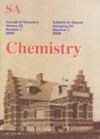水和二氧化硫在催化铂表面的竞争吸附:密度泛函理论研究
IF 1
4区 化学
Q4 CHEMISTRY, MULTIDISCIPLINARY
South African Journal of Chemistry-Suid-Afrikaanse Tydskrif Vir Chemie
Pub Date : 2021-01-01
DOI:10.17159/0379-4350/2021/v74a10
引用次数: 3
摘要
铂已被广泛用作杂化硫(HyS)循环制氢的催化剂。在这个循环中,水(H2O)和二氧化硫(SO2)反应生成硫酸和氢气。然而,铂对H2O和SO2的表面反应性尚未完全了解,特别是考虑到表面可能发生的竞争性吸附。在本研究中,我们进行了远距离色散校正的密度泛函理论计算[DFT-D3-(BJ)],以研究H2O和SO2对Pt(001),(011)和(111)表面的竞争效应。比较单个H2O分子在不同Pt表面的吸附,发现(001)表面对H2O的解离吸附获得的吸附能最低(Eads = -1.758 eV),其次是(011)表面(Eads = -0.699 eV)和(111)表面(Eads = -0.464 eV)。对于分子SO2的吸附,趋势相似,在(001)表面获得的吸附能最低(Eads = -2.471 eV),其次是(011)表面(Eads = -2.390 eV)和(111)表面(Eads = -1.852 eV)。在H2O和SO2的竞争吸附过程中,SO2分子会优先吸附在Pt表面。如果SO2浓度增加,相邻的两个SO2分子之间可能发生自反应,导致表面形成一氧化硫(SO)和-三氧化物(SO3),从而导致Pt催化表面的硫中毒。关键词:铂,水,二氧化硫,氢,吸附,密度泛函理论。本文章由计算机程序翻译,如有差异,请以英文原文为准。
Competitive Adsorption of H2O and SO2 on Catalytic Platinum Surfaces: a Density Functional Theory Study
ABSTRACT Platinum has been widely used as the catalyst of choice for the production of hydrogen in the hybrid sulphur (HyS) cycle. In this cycle, water (H2O) and sulphur dioxide (SO2) react to form sulphuric acid and hydrogen. However, the surface reactivity of platinum towards H2O and SO2 is not yet fully understood, especially considering the competitive adsorption that may occur on the surface. In this study, we have carried out density functional theory calculations with long-range dispersion corrections [DFT-D3-(BJ)] to investigate the competitive effect of both H2O and SO2 on the Pt (001), (011) and (111) surfaces. Comparing the adsorption of a single H2O molecule on the various Pt surfaces, it was found that the lowest adsorption energy (Eads = -1.758 eV) was obtained for the dissociative adsorption of H2O on the (001) surface, followed by the molecular adsorption on the (011) surface (Eads = -0.699 eV) and (111) surface (Eads = -0.464 eV). For the molecular SO2 adsorption, the trend was similar, with the lowest adsorption energy (Eads = -2.471 eV) obtained on the (001) surface, followed by the (011) surface (Eads = -2.390 eV) and (111) surface (Eads = -1.852 eV). During competitive adsorption by H2O and SO2, the SO2 molecule will therefore preferentially adsorb onto the Pt surface. If the concentration of SO2 increases, self-reaction between two neighbouring SO2 molecules may occur, leading to the formation of sulphur monoxide (SO) and -trioxide (SO3) on the surface, which could lead to sulphur poisoning of the Pt catalytic surface. Keywords: Platinum, water, sulphur dioxide, hydrogen, adsorption, density functional theory.
求助全文
通过发布文献求助,成功后即可免费获取论文全文。
去求助
来源期刊
CiteScore
3.10
自引率
0.00%
发文量
6
审稿时长
>12 weeks
期刊介绍:
Original work in all branches of chemistry is published in the South African Journal of Chemistry. Contributions in English may take the form of papers, short communications, or critical reviews.

 求助内容:
求助内容: 应助结果提醒方式:
应助结果提醒方式:


